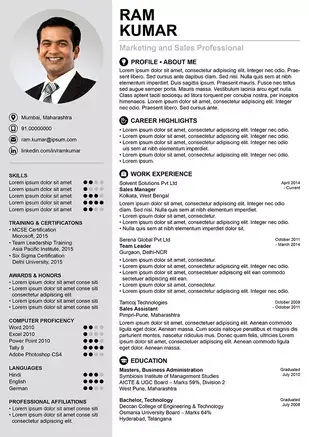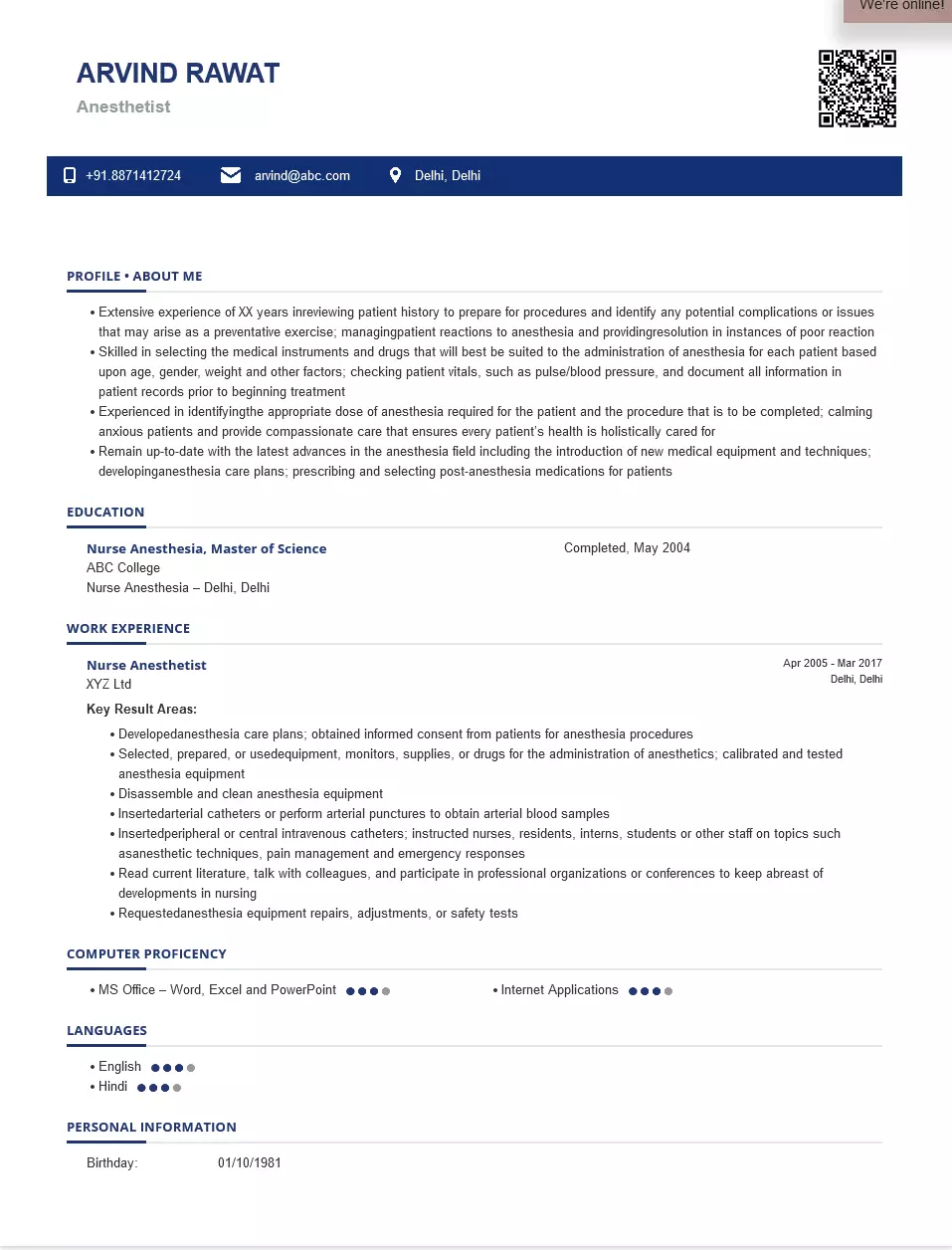- Certified Registered Nurse Anesthetist (CRNA), Completed , January 2018
What's your job?
Nurse Anesthetist Resume Samples and Templates for 2026
- Table of Contents
- Downloadable Sample
- Resume Tips from Experts
- Resume Text Version
- Share
Anesthesia Technician Resume Guide for India
A well-crafted Anesthesia Technician resume is essential for success in India’s specialized healthcare sector. Whether you’re a fresher completing your anesthesia technician course or an experienced professional seeking positions at corporate hospitals, government facilities, or specialty surgical centers, this guide provides everything you need to create a standout resume that impresses Indian employers and passes ATS screening on portals like Naukri and LinkedIn.
This comprehensive guide includes:
- Resume format recommendations for Indian anesthesia sector
- Key skills Indian employers look for
- Complete resume example with Indian context
- Top anesthesia technician employers in India
- Salary insights in INR by experience level
- Certification and course guidance for the Indian market
- ATS optimization tips for Indian job portals
Why Your Anesthesia Technician Resume Matters in India
India’s surgical and anesthesia services sector is growing rapidly with increasing surgical procedures across hospitals. Organizations like Apollo Hospitals, Fortis Healthcare, AIIMS, Medanta, Narayana Health, and various government medical colleges actively hire anesthesia technicians. A strong resume helps you:
- Stand out from thousands of anesthesia course graduates on Naukri and LinkedIn
- Pass ATS screening used by hospital chains and healthcare organizations
- Showcase skills that Indian hiring managers value, including anesthesia equipment handling, patient monitoring, and OT support
- Demonstrate your technical expertise and certification credentials
Indian healthcare recruiters typically spend 6-10 seconds reviewing each resume initially. Your Anesthesia Technician resume must immediately communicate your training, technical skills, and ability to support safe anesthesia administration. With India’s healthcare sector expanding surgical capacities, a well-optimized resume is essential.
Anesthesia Technician Resume Format for India
Indian employers prefer clean, professional resume formats. Here’s what works best:
Recommended Format
- Length: 1-2 pages (freshers: 1 page, experienced: 2 pages max)
- Layout: Reverse chronological (most recent first)
- Font: Arial, Calibri, or Times New Roman (11-12pt)
- Sections: Contact, Summary, Skills, Experience, Education, Certifications
Resume vs Biodata
In India, use a professional resume format for private hospital positions. “Biodata” format may be used for government hospital recruitment.
Personal Details for Indian Anesthesia Resumes
Indian resumes typically include:
- Full name with credentials
- Phone number with country code (+91)
- Professional email address
- LinkedIn profile URL
- City, State (full address not required)
What to Avoid
- Decorative fonts or graphics (causes ATS issues)
- Personal information like religion, caste, or father’s name
- Salary expectations (discuss during interview)
- References (provide when requested)
Key Skills for Anesthesia Technicians in India
Indian employers look for comprehensive anesthesia support expertise covering equipment handling, patient monitoring, and OT assistance.
Anesthesia Equipment
- Anesthesia Machine Operation: Boyle’s apparatus, modern anesthesia workstations
- Ventilator Management: Setup, monitoring, troubleshooting
- Monitoring Equipment: Pulse oximeter, capnograph, ECG, NIBP
- Airway Equipment: Laryngoscopes, endotracheal tubes, LMA, airways
- Equipment Maintenance: Checking, cleaning, sterilization
Clinical Skills
- Patient Preparation: Pre-anesthesia preparation, positioning
- Airway Management: Mask ventilation, intubation assistance
- IV Access: Cannulation support, fluid setup
- Drug Preparation: Drawing up anesthesia drugs, dilutions
- Patient Monitoring: Vital signs during surgery
OT Support
- OT Setup: Theatre preparation, equipment arrangement
- Sterile Technique: Asepsis, sterilization protocols
- Emergency Support: Crash cart preparation, emergency drugs
- Documentation: Anesthesia records, drug registers
- Inventory Management: Anesthesia supplies, drugs
Specialty Areas
- General Anesthesia: GA support and monitoring
- Regional Anesthesia: Spinal, epidural assistance
- Pediatric Anesthesia: Specialized pediatric support
- Cardiac Anesthesia: CTVS anesthesia support
- ICU Support: Post-operative monitoring
Soft Skills for Indian OT Settings
- Attention to Detail: Critical in anesthesia safety
- Quick Response: Emergency handling
- Teamwork: Coordination with anesthesia team
- Composure: Handling high-stress situations
How to Present Skills
Create a dedicated skills section. Group by category (Equipment, Clinical, OT Support). Highlight certifications prominently.
Anesthesia Technician Resume Example for India
Here’s a complete resume example tailored for Indian employers:
Rajesh Kumar
Delhi, NCR | +91-98XXX-XXXXX | rajesh.kumar.anesthesia@email.com | linkedin.com/in/rajeshkumar-anesthetist
Anesthesia Technician | B.Sc. Anesthesia Technology
Professional Summary
Skilled Anesthesia Technician with 6+ years of experience in anesthesia support, OT operations, and patient monitoring in India’s leading healthcare facilities. Expertise in anesthesia machine operation, airway management assistance, and patient monitoring with proven track record of supporting 1500+ surgical cases annually and maintaining 100% equipment readiness. Strong background in both general and specialty anesthesia including cardiac and pediatric surgery. B.Sc. in Anesthesia Technology from recognized institution with BLS and ACLS certifications. Seeking to contribute anesthesia expertise to a progressive surgical center.
Skills
Anesthesia Equipment: Anesthesia Machine Operation, Ventilator Management, Monitoring Devices, Airway Equipment, Defibrillator Clinical Support: Patient Preparation, Airway Assistance, IV Setup, Drug Preparation, Vital Signs Monitoring OT Operations: Theatre Setup, Sterile Technique, Emergency Support, Equipment Maintenance, Documentation Specialty: General Anesthesia, Regional Anesthesia, Pediatric Anesthesia, Cardiac Anesthesia, ICU Support Compliance: Infection Control, Patient Safety, Equipment Calibration, Drug Handling Protocols
Professional Experience
Senior Anesthesia Technician | Medanta - The Medicity | Gurugram | April 2021 – Present
- Support anesthesia administration for 400+ surgical cases monthly across 15 operation theatres
- Operate and maintain modern anesthesia workstations and monitoring equipment
- Prepare anesthesia drugs and maintain drug register with 100% accuracy
- Assist anesthesiologists with intubation, airway management, and regional anesthesia
- Monitor patients during surgery and alert team to any parameter changes
- Ensure 100% equipment readiness through daily checks and calibration
- Train and supervise 4 junior anesthesia technicians
- Support cardiac and neurosurgery anesthesia teams in complex cases
- Maintain zero equipment failure rate during surgeries
Anesthesia Technician | Fortis Hospital | Delhi | June 2018 – March 2021
- Provided anesthesia support in 10 OT complex handling multiple surgical specialties
- Prepared OT and anesthesia equipment before surgical cases
- Assisted in 300+ surgical cases monthly including emergency surgeries
- Managed anesthesia supply inventory and drug expiry tracking
- Participated in quality audits and infection control protocols
- Achieved consistent positive feedback from anesthesia department
Junior Anesthesia Technician | Sir Ganga Ram Hospital | Delhi | July 2017 – May 2018
- Completed internship and training in anesthesia technology
- Learned anesthesia equipment operation under supervision
- Assisted in OT preparation and patient positioning
- Gained experience in general and specialty anesthesia support
Key Achievements
Equipment Excellence Award | Medanta | 2022
- Achieved zero equipment downtime for 12 consecutive months
- Implemented preventive maintenance schedule for all anesthesia machines
- Result: Recognition from hospital quality committee, improved OT efficiency
Emergency Response Excellence | Medanta | 2021
- Quick response during intraoperative cardiac emergency
- Prepared emergency drugs and defibrillator within seconds
- Result: Commendation from chief anesthesiologist, successful patient outcome
Training Program Development | Fortis Hospital | 2020
- Created orientation training for new anesthesia technicians
- Developed equipment handling checklist for OT
- Result: Reduced training time by 25%, improved new hire competency
Education
Bachelor of Science in Anesthesia Technology (B.Sc. AT) | PGIMER, Chandigarh | 2017
- First Class (74%)
- Clinical Training: General Surgery, Cardiac Surgery, Neurosurgery, Obstetrics
- Internship: 1000+ supervised OT hours
Higher Secondary Certificate | CBSE | 2013
- 78% in Science stream (PCB)
Certifications
- Basic Life Support (BLS) | American Heart Association | 2018
- Advanced Cardiac Life Support (ACLS) | AHA | 2020
- Anesthesia Equipment Certification | Drager Training | 2019
- Infection Control and Prevention | Hospital Training | 2021
- Patient Safety in OT | NABH Training | 2020
Professional Memberships
- Member, Indian Society of Anesthesiologists (Associate)
- Member, Paramedical Staff Association
Technical Proficiency
- Anesthesia Machines: Drager, GE Healthcare, Mindray
- Monitoring: Philips, Nihon Kohden, GE Monitors
- Ventilators: Hamilton, Puritan Bennett, Drager
- Infusion Pumps: B. Braun, Fresenius Kabi
Languages
English (Fluent) | Hindi (Native) | Punjabi (Conversational)
Declaration
I hereby declare that the information provided above is true to the best of my knowledge.
Rajesh Kumar Delhi, December 2024
Top Anesthesia Technician Employers in India
India’s surgical sector offers excellent opportunities for anesthesia technicians. Here are the top employers:
Corporate Hospital Chains
- Medanta - The Medicity: Multi-specialty surgical center
- Apollo Hospitals: Pan-India, 71+ hospitals
- Fortis Healthcare: Multiple surgical centers
- Max Healthcare: Delhi NCR focus
- Narayana Health: High-volume surgical programs
- Manipal Hospitals: South India presence
Government Hospitals
- AIIMS: All India Institute of Medical Sciences
- PGIMER Chandigarh: Post Graduate Institute
- JIPMER Puducherry: Jawaharlal Institute
- Government Medical Colleges: All states
- District and State Hospitals: Pan-India
Specialty Hospitals
- NHSH (Narayana Hrudayalaya): Cardiac surgery focus
- Rajiv Gandhi Cancer Institute: Oncology surgeries
- Tata Memorial Hospital: Cancer surgeries
- Shalby Hospital: Orthopedic surgeries
- Sankara Nethralaya: Eye surgeries
Other Opportunities
- Ambulatory Surgery Centers: Day care surgical facilities
- Diagnostic Centers: Sedation services
- Maternity Hospitals: OBG anesthesia
- Dental Surgery Centers: Sedation support
- Endoscopy Centers: Procedural sedation
How to Apply
- Apply through Naukri.com and LinkedIn
- Hospital career pages directly
- Government recruitment (PSC, UPSC)
- Campus placements from anesthesia technology colleges
- Walk-in interviews at hospitals
Anesthesia Technician Salary in India
Anesthesia technology offers specialized careers with good growth. Salaries vary based on experience, employer type, and location.
Salary by Experience Level
| Experience | Government (INR) | Private Hospitals (INR) |
|---|---|---|
| Fresher (0-1 years) | ₹2.5 - ₹4 LPA | ₹2 - ₹3.5 LPA |
| Junior (1-3 years) | ₹4 - ₹6 LPA | ₹3.5 - ₹5.5 LPA |
| Mid-Level (3-7 years) | ₹6 - ₹9 LPA | ₹5.5 - ₹8.5 LPA |
| Senior (7-12 years) | ₹9 - ₹14 LPA | ₹8.5 - ₹13 LPA |
| Chief Technician (12+ years) | ₹14 - ₹20 LPA | ₹13 - ₹18 LPA |
Note: B.Sc. AT holders earn more than diploma holders. Cardiac and neuro anesthesia experience commands premium.
Salary by City
| City | Salary Range (Mid-Level) |
|---|---|
| Mumbai | ₹5.5 - ₹9 LPA |
| Delhi NCR | ₹5.5 - ₹9 LPA |
| Bangalore | ₹5 - ₹8.5 LPA |
| Chennai | ₹4.5 - ₹8 LPA |
| Hyderabad | ₹4.5 - ₹8 LPA |
| Kolkata | ₹4 - ₹7 LPA |
Factors Affecting Salary
- Qualification: B.Sc. earns more than diploma
- Specialty: Cardiac, neuro anesthesia premium
- Employer Type: Corporate hospitals pay more
- Location: Metro cities pay 20-30% higher
- Certifications: ACLS, specialty training add value
Salary data based on Glassdoor India, AmbitionBox, and industry surveys.
Certifications for Anesthesia Technicians in India
Professional qualifications are essential for anesthesia technology careers.
Core Qualifications
- B.Sc. in Anesthesia Technology: 3-4 year degree program
- Diploma in Anesthesia Technology: 2-year diploma
- Certificate Course: Short-term programs
- M.Sc. in Anesthesia Technology: Postgraduate program
Recognized Institutions
- AIIMS Delhi: B.Sc. Anesthesia Technology
- PGIMER Chandigarh: B.Sc. AT program
- JIPMER: B.Sc. Anesthesia Technology
- Government Medical Colleges: Various states
- Private Allied Health Colleges: Recognized programs
Professional Certifications
- BLS (Basic Life Support): Mandatory for OT work
- ACLS (Advanced Cardiac Life Support): Critical care support
- PALS (Pediatric Advanced Life Support): Pediatric surgery support
Equipment Certifications
- Drager Certified: Equipment operation training
- GE Healthcare Training: Monitoring equipment
- Ventilator Management: Advanced ventilator course
How to List Qualifications
Include degree, institution, and year. BLS/ACLS certifications should be prominently displayed.
ATS Tips for Your Anesthesia Technician Resume
Most hospital chains use Applicant Tracking Systems (ATS) to screen resumes. Optimize yours:
For Naukri.com
- Use keywords from job descriptions (anesthesia technician, OT, ventilator)
- Keep formatting simple (no tables, columns, or graphics)
- Use standard section headings (Experience, Education, Skills)
- Upload in .docx or .pdf format
- Update profile every 15 days
For LinkedIn Applications
- Match resume to LinkedIn profile
- Use standard job titles (Anesthesia Technician, OT Technician, Anesthesia Assistant)
- Include certifications and training
- Get endorsements from healthcare professionals
General ATS Tips
- DO: Standard fonts, clear headings, bullet points
- DO: Include metrics (400 surgeries monthly, 100% equipment readiness, zero failures)
- DO: Mention equipment brands and certifications
- DON’T: Use headers/footers, text boxes, images
- DON’T: Use creative section titles
Keyword Strategy for Anesthesia Roles
Common keywords from job postings:
- Anesthesia Technician, OT Technician, Anesthesia Assistant
- Anesthesia Machine, Ventilator, Patient Monitoring
- Airway Management, Drug Preparation, OT Setup
- General Anesthesia, Regional Anesthesia, Cardiac Anesthesia
- BLS, ACLS, B.Sc. Anesthesia Technology
Final Tips for Your Anesthesia Technician Resume
✅ Highlight technical skills—equipment operation, monitoring
✅ Quantify achievements (400 surgeries monthly, 100% readiness, zero failures)
✅ Show specialty experience—cardiac, neuro, pediatric anesthesia
✅ Include certifications—BLS, ACLS, equipment training
✅ Demonstrate safety focus—zero incidents, compliance
✅ Mention equipment proficiency—specific brands and models
✅ Proofread carefully—accuracy critical in anesthesia
Quick Checklist
- Contact with +91 phone and LinkedIn
- Professional summary highlighting anesthesia expertise
- Skills organized by category (Equipment, Clinical, OT Support)
- Experience showing surgical volume and outcomes
- Key achievements with measurable results
- Education with B.Sc. AT or diploma and percentage
- Certifications (BLS, ACLS, equipment training)
- Technical proficiency (equipment brands)
- Professional memberships
- ATS-friendly formatting
- Declaration statement
Ready to create your professional Anesthesia Technician resume? Use our resume builder to get started with expert-designed templates optimized for Indian job portals.
For more guidance on resume structure, check out our resume format guide with tips specifically for the Indian healthcare job market.
Nurse Anesthetist Text-Only Resume Templates and Samples
ARVIND RAWAT
Phone: 8871412724
Email: arvind@abc.com
Address: C-21, Sector-21, Delhi
About Me
Anesthetist
- An Experienced Nurse - Anesthetist, Significantly administering anesthesia, monitoring patient's vital signs, and overseeing patient recovery from anesthesia; adept at correctly and safely administering anesthesia services to patients, Quickly learns new procedures and responds to emergent situations with critical thinking and a fast-acting mindset
- Extensive experience of XX years in reviewing patient history to prepare for procedures and identify any potential complications or issues that may arise as a preventative exercise; managing patient reactions to anesthesia and providing resolution in instances of poor reaction
- Skilled in selecting the medical instruments and drugs that will best be suited to the administration of anesthesia for each patient based upon age, gender, weight, and other factors; checking patient vitals, such as pulse/blood pressure, and documenting all information in patient records prior to beginning treatment
- Experienced in identifying the appropriate dose of anesthesia required for the patient and the procedure that is to be completed; calming anxious patients and providing compassionate care that ensures every patient’s health is holistically cared for
- Remain up-to-date with the latest advances in the anesthesia field including the introduction of new medical equipment and techniques; developing anesthesia care plans; prescribing and selecting post-anesthesia medications for patients
Education
Nurse Anesthesia, Master of Science, Completed, May 2004
AIIMS
– Marks null
Delhi,
Certifications
Work Experience
Period: April 2019 - Current
Nurse Anesthetist
DSRP Enterprises
- Developed anesthesia care plans; obtained informed consent from patients for anesthesia procedures
- Selected, prepared, or used equipment, monitors, supplies, or drugs for the administration of anesthetics; calibrated and tested anesthesia equipment
- Disassemble and clean anesthesia equipment
- Inserted arterial catheters or perform arterial punctures to obtain arterial blood samples
- Inserted peripheral or central intravenous catheters; instructed nurses, residents, interns, students, or other staff on topics such as anesthetic techniques, pain management, and emergency responses
- Read current literature, talk with colleagues, and participate in professional organizations or conferences to keep abreast of developments in nursing
- Requested anesthesia equipment repairs, adjustments, or safety tests
Period: June 2014 - June 2017
Head Nurse
Aster Prime Hospitals
- Select and prescribe post-anesthesia medications or treatments to patients
- Administer post-anesthesia medications or fluids to support patients; cardiovascular systems
- Evaluate patients; post-surgical or post-anesthesia responses, taking appropriate corrective actions or requesting consultation if complications occur
- Perform pre-anesthetic screenings, including physical evaluations and patient interviews, and document results
- Select, order, or administer pre-anesthetic medications; discharge patients from the post-anesthesia care
- Monitor patients and responses, including skin color, pupil dilation, pulse, heart rate, blood pressure, respiration, ventilation, or urine output, using invasive and noninvasive techniques
- Perform or manage regional anesthetic techniques such as local, spinal, epidural, caudal, nerve blocks and intravenous blocks
- Prepare prescribed solutions and administer local, intravenous, spinal, or other anesthetics following specified methods and procedures
- Respond to emergency situations by providing airway management, administering emergency fluids or drugs, or using basic or advanced cardiac life support techniques Select, order, or administer anesthetics, adjuvant drugs, accessory drugs, fluids, or blood products as necessary; assess patients; medical histories to predict anesthesia response
Skills
- Surgery
- Advanced Cardiac Life Support (ACLS)
- Patient care
- Pain management
- Airway management
- Cardiopulmonary Resuscitation (CPR)
- Postoperative care
- Teaching ability
- Emergency Situations
- Ortho
- Medical Procedures
- Endoscopy
Languages
Softwares
Operating System
Personal Interests
- Yoga
- Cycling
- Reading
 India's
premier resume service
India's
premier resume service





